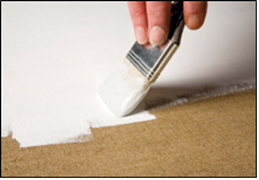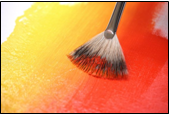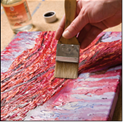How To Oil Out A Painting
1. PREPARING THE GROUND
The quality of the preparation largely determines the eventual durability of the artwork. Paper, cardboard, wood, cotton and linen can be used as grounds for oil paint, but not without prior treatment. An untreated or insufficiently treated ground will suck the oil out of the paint and will eventually be damaged by the oil. A paint layer must contain sufficient oil in order to surround the pigments and form a good film. Only then will the pigments be sufficiently bonded and premature splitting and cracking avoided.
Gesso is used to ensure a good preparation
Talens Gesso is made using a pure acrylic resin and is of superlative quality. Produced according to a special formula, gesso performs the functions of the various layers. The layer, however, must be thick enough, and so it is best to apply this in two goes. For the first layer the gesso can be thinned with water to an easily spreadable thickness. Next a second layer is applied, pure or slightly thinned with water.

For highly absorbent grounds the ground first can be treated with a layer of Amsterdam Acrylic binder, a pure unpigmented acrylic resin. The gesso can then be applied, preferably criss-cross in two (somewhat thinned) layers.
Talens stretched canvases, roll canvas and canvas boards have already been prepared.
2. APPLYING THE PAINT
There are in theory two oil painting techniques: 'alla prima' and 'layered painting'.
Alla prima
Alla prima refers to the painting being painted 'wet-into-wet'. With this technique the colours are mixed not only on the palette, but also in the painting itself, applied wet alongside and over one another. The painting, which is ultimately built up of a single layer, must be completed while the paint is still wet. The paint can be applied pure or combined with always the same medium or solvent.

Layered painting
With layered painting the painting is built up of various layers. A next layer can only be applied once the previous layer is dry enough to ensure that it will definitely not dissolve. With layered painting a technique has to be followed that is known as 'fat over lean'; every subsequent layer has to contain more oil.

You cannot always foresee exactly how many layers are needed to come to a satisfactory result. Ensure, therefore, that the paint is never too fat so that any subsequent paint layer is still able to bond. Pure oil as a medium is certainly not advisable; the paint can then become too sealed resulting in a subsequent layer not being able to bond well. What's more, with too much oil there is a greater risk of wrinkling of the paint film during the drying process.
Fat over lean
Ensure the first layer is applied lean. To this end the paint has to be thinned with white spirit or turpentine. While this layer dries it will not produce a sealed paint film, but a porous one. Oil from a subsequent layer will be absorbed by the underlying lean layer and secure itself in the numerous pores while drying. This will produce good adhesion between the two layers. As an underlying (lean) layer draws oil from the layer above, you have to ensure during painting that the layer above contains relatively more oil. If this is not the case, quality problems can arise.
The adhesion of the paint layers and the 'fat over lean' principle together also ensure that the tension between the various paint layers is absorbed. A painting is constantly exposed to movement – on the one hand by the flexibility of the grounds such as stretched canvas, and due to fluctuations in temperature and humidity on the other. To ensure the durability of the painting it is therefore important that all paint layers can absorb these movements.
The more oil a paint layer contains, the more elastic it will be once it is dry. If a painting were to consist of various layers whereby the lower layers contain more oil than the last layers, therefore against the 'fat over lean' rule, the less elastic top layers would then in due course be torn apart by the moving layers underneath When this becomes visible, it is referred to as cracking. Cracking can be avoided by making every subsequent layer a little fatter. 'Fat over lean' can therefore also be interpreted as 'elastic over less elastic'. This makes it immediately clear why a paint layer needs to dry sufficiently before applying the next layer. A layer that has not dried sufficiently is often too elastic for a next layer. And that can also cause cracks to form.
It is of course up to the artist how many layers are applied when building up a painting. It is advisable though to thin the paint with white spirit or turpentine for the first layer. The more solvent, the leaner the paint layer. When the first layer is dry enough the second paint layer can be applied. From this point there are several ways forward:
- Thin every subsequent layer with a decreasing amount of solvent; each subsequent layer therefore has to contain relatively more oil. This process can eventually be finished with pure paint.
- Mix the paint for the subsequent layer with a painting medium. A good medium consists of three components: oil, resin and solvent. The oil makes the paint fatter, whilst the solvent ensures that the paint does not become too fat. The resin as third ingredient increases the durability of the paint layer.
- If a painting is built up in more than two layers, the medium can be mixed proportionally with white spirit or turpentine from lean to increasingly fatter. The larger the relative amount of medium, the fatter the mixture. For the final layer the paint can be mixed with pure medium.
Besides the pigments used, the binder ensures for some important properties. Linseed oil has throughout the centuries shown itself to have the best combination of properties. As linseed oil shows some yellowing in time, it is sometimes replaced by safflower oil particularly for white paint. This oil yellows less, but it also has some disadvantages: it dries more slowly. Safflower oil is therefore not suitable for pasty use and lower paint layers.
Glazing
Whether a painting is made using the wet-into-wet technique or painting in layers, a glazing can be applied as a final layer. This is a transparent paint layer which has roughly the same effect as placing a coloured sheet of glass over a picture. The picture doesn't change, but the colours do. A glazing can be applied, for example, if the artist is not quite happy about the colours and wants to change them somewhat without having to paint over entire areas. Also, the artist may wish to achieve the visual effect of glazing layers; an enamel-like top layer and deep colours. An underpainting would then be used as a starting point to modify the colour of the entire painting with one or several layers of glazing.
Brush strokes must not be visible in a glazing as you will continue to see the brush stroke of the underlying layers through the transparent paint; a glazing medium therefore has to flow. Thanks to this property you can also make flowing colour transitions in a glazing.
A layer of glazing has to be more elastic than the underlying paint film as here, too, the 'fat over lean' rule has to be followed. Various mediums are suitable for this purpose.

Storing and drying freshly-created paintings
The drying of the oil is a chemical process that occurs under the influence of air and light. Oxygen is absorbed by the oil, causing the molecules to cross link into a network. Energy is required for this oxidation process, which is supplied mainly by ultraviolet light. This entire process takes some time, which is the reason why oil paint takes so long to dry. The greater the ventilation and light, the faster the drying. A low ambient temperature and high humidity adversely affects the drying process.
This is whyfreshly-created paintings have to dry in a room with enough light (not direct sun), at around room temperature and low air humidity.
A painting has to be completely dry throughout before it is varnished!
3. APPLYING THE VARNISH
Varnishes for oil paints generally consist of resin dissolved in a solvent. They protect the paint layer and determine the gloss of the work. A good varnish must be reversible. That is to say that, for example, in the case of a restoration it should always be possible to remove it with a solvent without damaging the paint layer, also after many years.
Retouching varnish
During painting sunken-in areas can arise. This can occur if in a particular area too much oil is absorbed by an underlying layer; the paint becomes matt and the colour loses intensity. Due to the strong suction of these areas, too much oil would be sucked away when a next layer is applied. Once the sunken-in areas are hand-dry, apply a thin layer of retouching varnish in order to return gloss and colour to the area, and consequently also the harmony of the work. What's more, this ensures that too much oil is also not sucked away from a following layer. In a thin layer after drying the varnish leaves a porous film into which a subsequent paint film can adhere. When used for this application retouching varnish can sometimes also be referred to as 'intermediate varnish'.
In addition, retouching varnish can be used as a temporary protective varnish on paintings that are not yet completely dry. This gives the painting an even gloss and protects it against dirt. As the varnish is porous (in a thin layer), oxygen absorption and consequently also the drying process of the paint can continue. Once the paint is completely dry a final varnish can be applied over the retouching varnish.
It is very important that the retouching varnish is always applied in very thin layers. If used as an intermediate varnish too much varnish will impair a good adhesion of any subsequent layer. With excessive use as a temporary protective varnish the solvent of the varnish can dissolve the oil from the lower paint layers (that are not yet dry) and bring it to the surface. If this happens the painting may remain sticky for many months or even years, and will make it difficult to stop dust adhering to it. With normal layer thicknesses it is therefore important to wait at least 2 to 3 months before applying it.
Final varnish
Oil paint dries under the influence of oxygen and light. This is a chemical process. Once the paint is dry this oxidation process does not stop but continues in an ageing process. Eventually this can be visible as cracking. Once the paint is sufficiently dry (with layers of normal thickness this takes approximately one year, with very thin layers several months less, and with thicker layers several years) it is therefore advisable to apply a final varnish. This final varnish slows down the oxygen absorption and consequently the ageing process. This also determines the eventual degree of gloss and the paint is protected against atmospheric contamination.

When varnishing ensure that everything (painting, varnish, brush and trays) are at room temperature. If a painting is taken out of a cold room into a warm room in order to be varnished condensation can form on the cold painting. Moisture would therefore be sealed within the varnish resulting in a white haze inside the film. What's more, the moisture on the painting can cause the varnish to bead and decrease the adhesion.
Beading can also occur if the paint layer is very sealed, for example when this contains a great deal of binder (medium, oil). In order to prevent this it is advisable to first wipe the painting with a cloth with some white spirit. Once the white spirit has evaporated the varnish can be applied.
Glossy picture varnishes consist mainly of a resin in a solvent. In the case of matt varnishes a matting agent has been added. When using a brush to apply a varnish with a matting agent (therefore also with mixtures of glossy and matt varnish), it is important that the varnish is applied at the end in brush strokes in one direction. This helps to ensure a uniform degree of gloss.
What's more, it is important that a varnish with a matting agent is applied in one layer. This helps to prevent differences in gloss and stripe formation. If, however, matt varnish is applied with a spray can, this can be done in several layers.
The matting agent in Talens Picture varnish matt is a combination of waxes that flocculate under low temperatures. By heating up the varnish ('au bain marie' or under trickling hot water) the waxes are dissolved and the varnish can be used again.
How To Oil Out A Painting
Source: https://www.royaltalens.com/en/inspiration/tips-techniques/the-construction-and-finishing-of-an-oil-painting/
Posted by: mcdonaldyone1997.blogspot.com

0 Response to "How To Oil Out A Painting"
Post a Comment